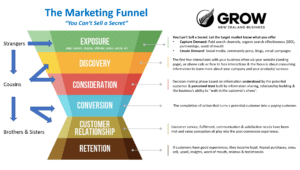For most of us business owners, we start a business because we have a passion for an industry and we want to create value for ourselves and our family. Over time, however, it’s easy to get swept up in day-to-day business life and lose sight of the reason we started in the first place. This absence of clarity is not only dangerous for our sense of purpose, it can often lead to a significant loss in potential commercial value.
Staying on top of how to maximise the value of your business is essential; After all, as your source of income, your future – and in many cases your family’s future – depends on it! At Grow NZ, we’ve seen many smart business owners fall short when it comes to understanding how to maximise the current and future value of their companies. So, as always, we are here to help and we’ve dedicated our April webinar to the topic.
Register here to join our ‘Maximise Your Business Value’ webinar on Tuesday 13 April at 10am. It’s free for Grow NZ members. Just enter the code: GROWNZMEMBER in the ‘Enter Promo Code’ box to grab your complimentary ticket. There’s nothing to lose and a world of profit to gain.
We look forward to seeing you on the 13th, in the meantime, let’s push forward in our journey to over-managing our business for growth.
Over-managing: A quick recap on what we already know.
1/ You must be very deliberate in what you choose to over-manage. It will require a heap of energy and focus and should align directly to the achievement of your business goals.
2/ Always, always, walk in your customers’ shoes – understand their purchasing journeys, their needs and wants, what they are willing to pay and what delights them (fast delivery or excellent customer service are two examples). Over-managing something that doesn’t interest your customer is frankly a waste of time, money and growth opportunity.
3/ Remember that digital is not the solution, it is the enabler. Yes, the stats we shared earlier in the month are compelling, but these insights are complicated and you must walk in your customers’ shoes first before considering any form of a digital strategy. The right experts will guide you through this process.
4/ Know your Brothers, Sisters, Cousins & Strangers and make sure you craft and implement different communication strategies for each of these relationships. Taking different approaches to different customer segments based on how well each knows your brand and the products and/or services your business offers, is the fastest way to connect with and convert customers.
Now what?

Now it’s time to start bringing everything together and it all comes back to the fact You Can’t Sell a Secret. The first step is to get your marketing funnel and landing pages ship-shape.
What is a landing page?
In marketing terms, a landing page is a standalone web page, created specifically for a marketing or advertising campaign. It’s where a visitor ‘lands’ after they click on a link in an email, or ads from Google, Bing, YouTube, Facebook, Instagram, Pinterest, or similar places on the web.
A landing page is a great way to drive traffic, improve your SEO (Search Engine Optimisation or ‘findability’) and build your brand. Landing pages lead customers to a specific product, service or offer and encourage them to take action. This is your opportunity to create conversions and build your customer base by imparting knowledge and building trust.
Unlike web pages, which typically have many goals and encourage exploration, landing pages are designed with a single focus or goal, known as a call to action (or CTA, for short). It’s this focus that makes landing pages the best option for increasing the conversion rates of your marketing campaigns and lowering your cost of acquiring a lead or sale, therefore increasing your return on investment.
The other benefit of landing pages is the way they can optimise your paid search results via Quality Scores. It is not uncommon for businesses to have more than 20 landing pages, aligned to different target customer segments and what we call ‘big hitting keywords’.
We will touch on this more next week and explain how critical it is to ensure you are getting the best returns from your marketing activities.
Don’t forget the legal bits.
There’s some legal stuff you must be aware of with your website and landing pages.
If your business collects any personal information, you must comply with the New Zealand Privacy Act 2020 (the Act). Personal information is any information about an identifiable individual (a natural person). It includes, without limit, name, address details, and personal preferences. Failure to comply with the Act may result in fines and reputational damage.
What is a privacy statement?
A privacy statement tells people how you will be collecting, using and disclosing their information.
The Privacy Act 2020 requires New Zealand organisations to be transparent about how, when, and why they collect personal information.
Make sure your privacy statement is clearly displayed on your website and all landing pages.
Make sure you comply with the Web Usability Standard.
The privacy requirements in the New Zealand Government’s Web Usability Standard are a combination of the Privacy Act 2020 and accepted best practice that you should consider when creating privacy statements on public-facing sites.
Write your own privacy statement.
The Office of the Privacy Commissioner has developed Priv-o-matic, a tool to help businesses create basic privacy statements. It is ideal for small to medium-sized organisations.
Other information to include:
You may also choose to add targeted messages to your privacy statement for specific contexts, such as when your website collects a user’s information submitted in an online form. Here’s an example from digital.govt.nz.

